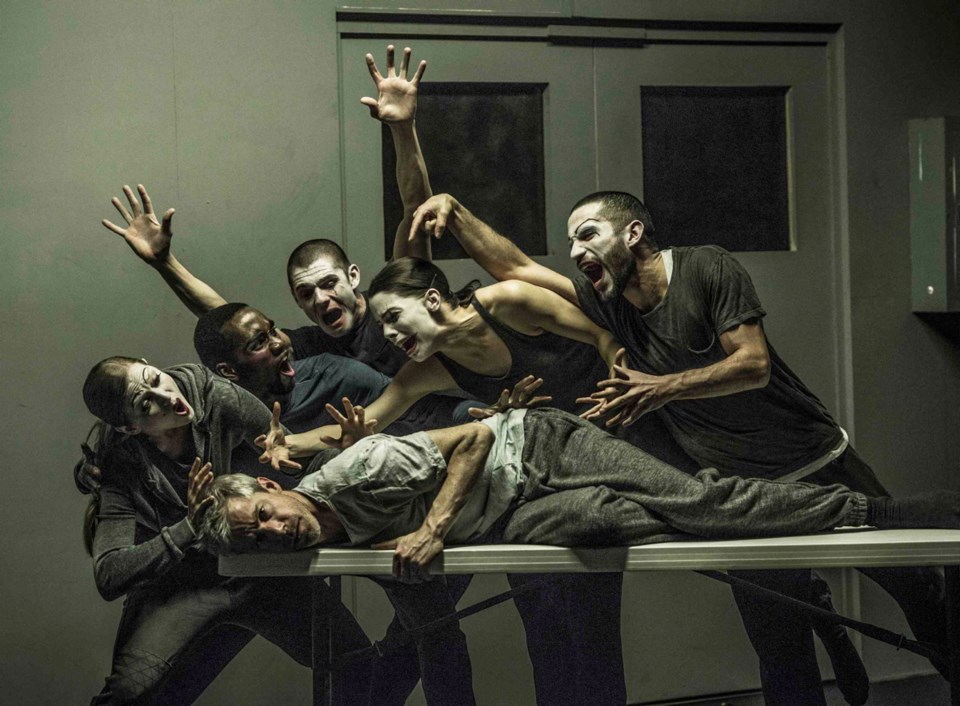What: Betroffenheit
Where: Royal Theatre
When: Friday, Saturday
Making art based on profound personal tragedy is tricky. In confronting one’s own pain, it’s difficult to have artistic objectivity.
The artist might wonder: “Am I creating something that transcends my own experience? Is this art? Is this art as therapy?”
Vancouver theatre artist Jonathan Young did something extraordinarily brave when he teamed up with choreographer Crystal Pite to create the dance-theatre piece, Betroffenheit. The two-hour work for Young and five dancers is directly inspired by a 2009 cabin fire that took the lives of his daughter and her two cousins.
Betroffenheit isn’t an easy piece to watch, or respond to. Raw, hallucinatory and visceral, we watch its protagonist (Young) experience a terrible catastrophe. Post-traumatic stress disorder and substance abuse appear to follow.
Ultimately, a measure of peace, or at least resignation, is found at the end, when Jermaine Spivey of Pite’s superb Kidd Pivot company dances a poignant solo to elegiac music. Most often, though, Betroffenheit is an imaginative and nightmarish exploration of human pain and suffering. At times, it’s akin to watching a Hieronymus Bosch painting come to life.
We first meet Young stage left, crouched in a ball. He’s in what looks like an abandoned auto garage, industrial and bleak. Soon emergency responder chatter is broadcast: “What do we say? … What’s happened? … It’s an emergency!”
On a dimly lit stage, Young’s character is plunged into turmoil while industrial noises sound relentlessly. Drugs (or something like it) enter his world; we hear such phrases as “what does the user need?” Other utterances provide a fragmented suggestion of some terrible event: “They’re in there … it’s too late … it’s collapsing.”
We enter a distortion of the show-biz scene, with white-faced, bowler-hatted creatures dancing menacingly. This culminates into a pink-feathered Las Vegas-style routine, a sort of obscene parody. A six-person tap dance is no less menacing.
Young appears in a cheesy long-hair wig and an electric blue suit. He introduces himself as the host, overseeing his own not-so-private hell. An identically costumed doppelganger (Spivey) joins Young for a dance that mimics joyfulness but in fact epitomizes desperation. Typically, we hear spooky applause — obviously pre-recorded. There’s a strong feeling of living life by going through the motions in a hollow, grotesque manner.
The sense of oddness and displacement is further amplified when Young reappears on stage, this time in distorted form as dwarf. “Just give me a bit!” he pleads.
Betroffenheit’s second act is more abstract, less of a horrifying parody. The performers assemble on stage right, in drab street clothes. The dance — sometimes marked by bold over-the-shouder lifts — was precise and beautifully executed.
Here the grief experienced by Young’s character entered a new phase. Compared to Act I, the movement had a more organic feel, swirling and intertwined. The impression was of torment that hadn’t lessened but merely changed form, becoming more private, more internal.
One of the final images is of Young half-collapsed on stage, supported by the other dancers, a Christ-like pose reminiscent of Michelangelo’s Pieta.
Betroffenheit was well-received on Friday night, earning three curtain calls from an enthusiastic audience. My own feelings were mixed. Famously (or perhaps infamously) dance critic Arlene Croce refused to review a Bill T. Jones performance in the 1990s because it featured footage of terminally ill people. Croce’s notion was such a performance is beyond criticism.
Certainly, Betroffenheit isn’t quite what came to be known as “victim art.” Yet, it’s difficult to treat this work as just another performance to be evaluated solely on its artistic merits (for this review I haven’t used the Times Colonist’s usual star-rating system) .
As impressive as it is in many ways, for my taste Betroffenheit is overly raw and unrelenting. It’s true, much variety is presented in terms of sound and visuals. And the level of dance is wonderful; impressively, Young, who’s primarily a writer and an actor, danced very well. That said, the overriding tone seemed overly monochromatic — an evening-length cry of pain.
Perhaps that’s precisely the intent. And in any case, who among us can deny Young what he has experienced? Who can deny, or even criticize, the legitimacy of his artistic reaction to it?



